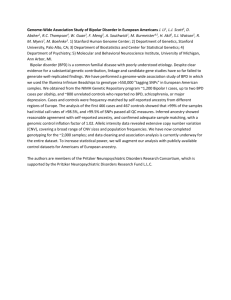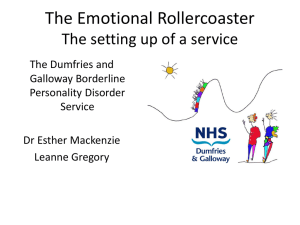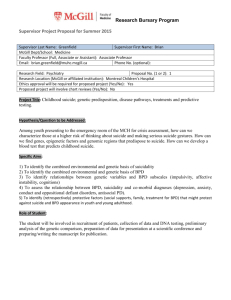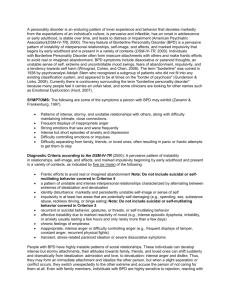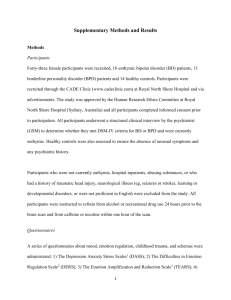Understanding borderline personality disorder
advertisement
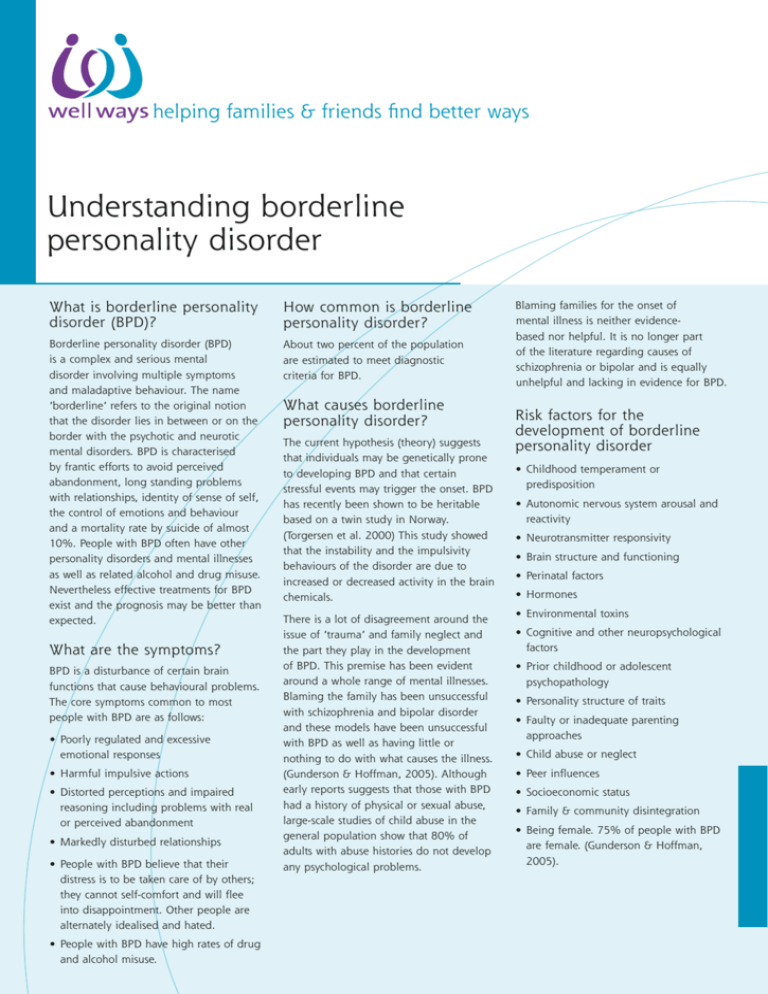
helping families & friends find better ways Understanding borderline personality disorder What is borderline personality disorder (BPD)? How common is borderline personality disorder? Borderline personality disorder (BPD) is a complex and serious mental disorder involving multiple symptoms and maladaptive behaviour. The name ‘borderline’ refers to the original notion that the disorder lies in between or on the border with the psychotic and neurotic mental disorders. BPD is characterised by frantic efforts to avoid perceived abandonment, long standing problems with relationships, identity of sense of self, the control of emotions and behaviour and a mortality rate by suicide of almost 10%. People with BPD often have other personality disorders and mental illnesses as well as related alcohol and drug misuse. Nevertheless effective treatments for BPD exist and the prognosis may be better than expected. About two percent of the population What are the symptoms? BPD is a disturbance of certain brain functions that cause behavioural problems. The core symptoms common to most people with BPD are as follows: •Poorly regulated and excessive emotional responses •Harmful impulsive actions •Distorted perceptions and impaired reasoning including problems with real or perceived abandonment •Markedly disturbed relationships •People with BPD believe that their distress is to be taken care of by others; they cannot self-comfort and will flee into disappointment. Other people are alternately idealised and hated. •People with BPD have high rates of drug and alcohol misuse. are estimated to meet diagnostic criteria for BPD. What causes borderline personality disorder? The current hypothesis (theory) suggests that individuals may be genetically prone to developing BPD and that certain stressful events may trigger the onset. BPD has recently been shown to be heritable based on a twin study in Norway. (Torgersen et al. 2000) This study showed that the instability and the impulsivity behaviours of the disorder are due to increased or decreased activity in the brain chemicals. There is a lot of disagreement around the issue of ‘trauma’ and family neglect and the part they play in the development of BPD. This premise has been evident around a whole range of mental illnesses. Blaming the family has been unsuccessful with schizophrenia and bipolar disorder and these models have been unsuccessful with BPD as well as having little or nothing to do with what causes the illness. (Gunderson & Hoffman, 2005). Although early reports suggests that those with BPD had a history of physical or sexual abuse, large-scale studies of child abuse in the general population show that 80% of adults with abuse histories do not develop any psychological problems. Blaming families for the onset of mental illness is neither evidencebased nor helpful. It is no longer part of the literature regarding causes of schizophrenia or bipolar and is equally unhelpful and lacking in evidence for BPD. Risk factors for the development of borderline personality disorder •Childhood temperament or predisposition •Autonomic nervous system arousal and reactivity •Neurotransmitter responsivity •Brain structure and functioning •Perinatal factors •Hormones •Environmental toxins •Cognitive and other neuropsychological factors •Prior childhood or adolescent psychopathology •Personality structure of traits •Faulty or inadequate parenting approaches •Child abuse or neglect •Peer influences •Socioeconomic status •Family & community disintegration •Being female. 75% of people with BPD are female. (Gunderson & Hoffman, 2005). Understanding borderline personality disorder continued… Treatment and recovery from borderline personality disorder Treatment can be effective for BPD over time. Unlike other mental illnesses, for which medication is the primary treatment, support and behavioural strategies are the cornerstone of treatment for people experiencing BPD. Medications are used effectively at times to treat the symptoms of BPD. For example, Anti-depressants are used to alleviate the symptoms of depression and Valium is used for anxiety. Helping people understand the emotions triggering their behaviour, choosing different behaviours when they are triggered and taking responsibility for themselves and their behaviour is a large focus of the treatment. Associated symptoms such as depression or anxiety are treated with appropriate medication. Dialectical Behavioural Therapy is the most widely used cognitive-behavioural therapy for BPD. The goals of the therapy are to reduce lifethreatening behaviours, address behaviours that interfere with the treatment process itself, and modify behaviours that significantly impair the patient’s quality of life. The following table details useful interventions for specific symptoms: Behavioural Symptom Helpful Interventions Frantic efforts to avoid real or imagined abandonment •Let the person know when you are leaving the room or stepping away from them •When the person with BPD becomes upset or angry, it may help to think about whether anything has happened that has triggered his or her fear of abandonment A pattern of unstable, intense personal relationships with views of people alternating between “all good” idealisation and “all bad” devaluation •It is important that you maintain a consistent balanced view of yourself at all times particularly when the person with BPD views you in glowing, positive terms. This will help you stay on an even keel during those times when you are being devalued •Be consistent in your view of the relationship and your boundaries within it •Minimise any visible reaction •Minimise your exposure to situations that trigger the person into these symptoms Identity disturbance: markedly and persistently unstable self-image or sense of self •Reinforce the positive role the person has as a family member or friend. This may help provide him or her with an identity, heighten feelings of control, and lessen feelings of emptiness Impulsivity in areas that are potentially self-damaging eg spending, sex, substance use, shoplifting, reckless driving, or binge eating •Set clear boundaries on what behaviour you will tolerate in the home NB. Harmful activities may be a way of expressing rage or self-hate. If the person with BPD in your life is actively abusing drugs and/or alcohol, it can be difficult to determine what behaviour is related to BPD and what is related to substance abuse •Take action to protect assets when necessary •Reduce access to dangerous situations eg put car keys in a safe spot when necessary Behavioural Symptom Helpful Interventions Recurring suicidal behaviour, gestures, or threats, or self-mutilating behaviour •Notify the person’s doctor immediately •Remain calm and speak in a calm and matter-of-fact way Do not add to the person’s inner chaos with your own panic •Emphasise that you are trying to understand how the person is feeling •Reinforce your love and acceptance of the person, while making it clear that you wish he or she would find another way of handling problems eg “I feel helpless and angry when you hurt yourself. I want to understand this, even though I don’t fully. But I know you don’t want to do this anymore” •Suggest alternatives to self-harm activities that produce an intense sensation that is not harmful such as squeezing ice or plunging hands into very cold water •Do not agree to secrecy •Avoid statements that evoke feelings of shame or guilt Affective instability due to a marked reactivity of mood •Emphasise messages of love and acceptance for the person NB. Intense feelings of depression and anguish or anxiety usually last a few hours and only rarely more than a few days Chronic feelings of emptiness •Empathise with the person. Show that you are trying to understand how he or she is feeling •Really listen •Ask questions in a concerned way, such as “How are you feeling?” and “Is there anything I can do?” •Don’t underestimate the person’s feeling. Imagine the worst you have ever felt, and then triple it Inappropriate, intense anger or difficulty controlling anger (eg frequent displays of temper, constant anger, recurrent physical fights) • Be aware of your own safety. During a rage, the best thing to do is temporarily remove yourself from the situation •Say calmly, “I will not discuss this further with you if you continue to yell and scream at me. I am willing to be supportive if you can calmly tell me what it is that you want or need” •Go to a safe place eg a friend’s house •Ignore letters or emails sent in anger •Do not respond with anger. Remember, the person is sick and scared, not angry Transient, stress-related paranoid ideation or severe dissociative symptoms NB. Dissociation involves the loss of a person’s ability to integrate normal functions of identity, memory and consciousness eg memory of a traumatic event may be lost or the emotion attached to it lost. People with BPD may dissociate to different degrees to escape from painful feelings or situations •Be patient. Do not make demands •Try not to be frustrated or hurt by the lack of emotion that the person displays Understanding borderline personality disorder continued… What can family and friends do to help? In addition to the specific interventions previously mentioned, there are many things friends and family can do to help. Useful references Remember to stay healthy yourself. Do not underestimate the impact of the illness on you. BPD often involves trauma and grief and has an impact on whole families. Be prepared to seek support to develop strategies that keep you well. Mental Health Services Website (Vic) www.health.vic.gov.au/mentalhealth Find out as much about the illness as you can. Knowledge is power and gives you a much better chance of developing good coping strategies. Be patient. People experiencing BPD need to come to some insight regarding their illness. This is not always easy and takes time. Know what to expect of the mental health system and be prepared to be assertive in seeking appropriate care. Mental Illness Fellowship Victoria www.mifellowship.org National Alliance of the Mentally Ill (NAMI) (USA) www.nami.org Mental Health Council of Australia www.mhca.com.au SANE Australia www.sane.org Beyond Blue www.beyondblue.org.au Australian Drug Foundation www.adf.org.au Mental Illness Fellowship of Australia fact sheets Understanding suicide and mental illness Mental illness and violence What can family and friends do to help a person experiencing mental illness? Family and carer supports and services PUBLISHED BY: Mental Illness Fellowship of Australia 08 8221 5072 www.mifa.org.au Mental Illness Fellowship Nth Qld Inc 07 4725 3664 www.mifnq.org.au Schizophrenia Fellowship of Qld Inc 07 3358 4424 www.sfq.org.au Mental Illness Fellowship of Sth Australia Inc 08 8378 4100 www.mifsa.org Mental Health Carers NT 08 8948 1051 www.mentalhealthcarersnt.org Mental Illness Fellowship Victoria 03 8486 4200 www.mifellowship.org Schizophrenia Fellowship of NSW Inc 02 9879 2600 www.sfnsw.org.au Mental Illness Fellowship of WA Inc 08 9228 0200 www.mifwa.org.au ARAFMI (Tas) Inc Launceston 03 6331 4486 Moonah 03 6228 7448 www.arafmitas.org.au ©Mental Illness Fellowship Victoria 2008 (ACN 093357165) The involvement of family in the treatment of serious psychiatric disorders experienced by other family members has been shown to be helpful both for the patient and for the family itself. The emerging data also support various types of family involvement in the treatment of BPD. Mental Illness Fellowship of Australia www.mifa.org.au MIFV2008/07-7 Always remember that borderline personality disorder is a medical condition that requires psychological treatment and support. Just as you cannot stop a person’s leg bleeding by talking to them, you cannot stop BPD without intervention. Treatment is effective over a period of time. Link in with community organisations that offer supports and services that complement the mental health service system. They often provide educational programs, counselling and local support groups.
